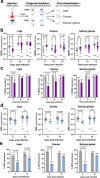Mosquito immune cells enhance dengue and Zika virus infection in Aedes aegypti
- PMID: 40593674
- PMCID: PMC12214649
- DOI: 10.1038/s41467-025-61139-9
Mosquito immune cells enhance dengue and Zika virus infection in Aedes aegypti
Abstract
Mosquito-borne arboviruses cause more than 400 million annual infections, yet despite their public health importance, the mechanisms by which arboviruses infect and disseminate in the mosquito host are not well understood. Here, we provide evidence that dengue virus and Zika virus actively infect Aedes aegypti hemocytes and demonstrate, through phagocyte depletion, that hemocytes facilitate virus infection to peripheral tissues including the ovaries and salivary glands. Adoptive transfer experiments further reveal that virus-infected hemocytes efficiently confer virus infection to naïve recipient mosquitoes. Together, these data support a model of arbovirus dissemination where infected hemocytes enhance virus infection of mosquito tissues required for transmission, which parallels vertebrate systems where immune cell populations promote virus dissemination. This study significantly advances our understanding of virus infection dynamics in the mosquito host and highlights potential conserved roles of immune cells in arbovirus infection across vertebrate and invertebrate systems.
© 2025. The Author(s).
Conflict of interest statement
Competing interests: The authors declare no competing interests.
Figures







Update of
-
Mosquito immune cells enhance dengue and Zika virus dissemination in Aedes aegypti.bioRxiv [Preprint]. 2024 Apr 4:2024.04.03.587950. doi: 10.1101/2024.04.03.587950. bioRxiv. 2024. Update in: Nat Commun. 2025 Jul 1;16(1):5891. doi: 10.1038/s41467-025-61139-9. PMID: 38617257 Free PMC article. Updated. Preprint.
Similar articles
-
Mosquito immune cells enhance dengue and Zika virus dissemination in Aedes aegypti.bioRxiv [Preprint]. 2024 Apr 4:2024.04.03.587950. doi: 10.1101/2024.04.03.587950. bioRxiv. 2024. Update in: Nat Commun. 2025 Jul 1;16(1):5891. doi: 10.1038/s41467-025-61139-9. PMID: 38617257 Free PMC article. Updated. Preprint.
-
Restriction of Zika virus infection and transmission in Aedes aegypti mediated by an insect-specific flavivirus.Emerg Microbes Infect. 2018 Nov 15;7(1):181. doi: 10.1038/s41426-018-0180-4. Emerg Microbes Infect. 2018. PMID: 30429457 Free PMC article.
-
Natural vertical transmission of dengue virus in Aedes aegypti and Aedes albopictus: a systematic review.Parasit Vectors. 2018 Feb 1;11(1):77. doi: 10.1186/s13071-018-2643-9. Parasit Vectors. 2018. PMID: 29391071 Free PMC article.
-
Cell fusing agent virus rarely transmits vertically in artificially infected laboratory-colonized Aedes aegypti mosquitoes.Parasit Vectors. 2024 Apr 4;17(1):177. doi: 10.1186/s13071-024-06232-6. Parasit Vectors. 2024. PMID: 38575981 Free PMC article.
-
Zika virus: An updated review of competent or naturally infected mosquitoes.PLoS Negl Trop Dis. 2017 Nov 16;11(11):e0005933. doi: 10.1371/journal.pntd.0005933. eCollection 2017 Nov. PLoS Negl Trop Dis. 2017. PMID: 29145400 Free PMC article.
Cited by
-
Aedes aegypti VLG-1 challenges the assumed antiviral nature of Vago genes.BMC Biol. 2025 Jul 28;23(1):223. doi: 10.1186/s12915-025-02325-5. BMC Biol. 2025. PMID: 40717062 Free PMC article.
-
Polygenic viral factors enable efficient mosquito-borne transmission of African Zika virus.bioRxiv [Preprint]. 2025 Jan 24:2025.01.23.634482. doi: 10.1101/2025.01.23.634482. bioRxiv. 2025. PMID: 39896559 Free PMC article. Preprint.
-
Exploring new dimensions of immune cell biology in Anopheles gambiae through genetic immunophenotyping.bioRxiv [Preprint]. 2024 Oct 25:2024.10.22.619690. doi: 10.1101/2024.10.22.619690. bioRxiv. 2024. PMID: 39484609 Free PMC article. Preprint.
-
A genome-wide CRISPR screen in Anopheles mosquito cells identifies essential genes and required components of clodronate liposome function.bioRxiv [Preprint]. 2024 Sep 24:2024.09.24.614595. doi: 10.1101/2024.09.24.614595. bioRxiv. 2024. PMID: 39386635 Free PMC article. Preprint.
References
-
- Fauci, A. S. & Morens, D. M. Zika virus in the Americas — yet another arbovirus threat. N. Engl. J. Med.374, 601–604 (2016). - PubMed
MeSH terms
Grants and funding
- R01 AI148477/AI/NIAID NIH HHS/United States
- R21 AI149118/AI/NIAID NIH HHS/United States
- AI149118/U.S. Department of Health & Human Services | NIH | National Institute of Allergy and Infectious Diseases (NIAID)
- AI148477/U.S. Department of Health & Human Services | NIH | National Institute of Allergy and Infectious Diseases (NIAID)
LinkOut - more resources
Full Text Sources
Medical

